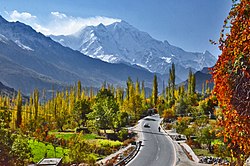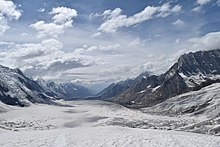| Revision as of 11:17, 6 January 2024 edit101.53.255.55 (talk) →Mountain peaks← Previous edit | Revision as of 17:05, 27 January 2024 edit undo174.198.10.216 (talk) →Mines and MineralsTags: Mobile edit Mobile web editNext edit → | ||
| Line 116: | Line 116: | ||
| == Mines and Minerals == | == Mines and Minerals == | ||
| Nagar is considered to be one of |
Nagar is considered to be one of the gemstone-rich valleys of Gilgit-Baltistan. It contains numerous mining sites that yield a range of precious and semiprecious gemstones. | ||
| ===Mining Sites=== | ===Mining Sites=== | ||
Revision as of 17:05, 27 January 2024
Valley in Gilgit Baltistan, Pakistan.| This article needs additional citations for verification. Please help improve this article by adding citations to reliable sources. Unsourced material may be challenged and removed. Find sources: "Nagar Valley" – news · newspapers · books · scholar · JSTOR (December 2018) (Learn how and when to remove this message) |
Place in Gilgit Baltistan, Pakistan
| Nagar Valley | |
|---|---|
 The 7,788 m (25,551 ft) tall Rakaposhi as seen from the Hunza Valley The 7,788 m (25,551 ft) tall Rakaposhi as seen from the Hunza Valley | |
 | |
| Coordinates: 36°15′55″N 74°42′49″E / 36.2652548°N 74.7135025°E / 36.2652548; 74.7135025 | |
| Country | Pakistan |
| Region | Gilgit Baltistan |
| District | Nagar District |

Nagar Valley once a princely state, now stands as one of the ten districts within the Gilgit-Baltistan region of Pakistan. This valley is situated along the renowned Karakoram Highway, as one travels northward from the city of Gilgit. The valley is home to many high mountain peaks including Rakaposhi (7788m), Diran Peak (7265m), Golden Peak and Rush Peak.
The Nagar valley is administratively divided into two tehsils: Nagar-I and Nagar-II. All the villages of upper Nagar including Shayar, Askurdas, Sumayar, Nagarkhas, Hoper Valley, and Hispar come under Nagar-I, whereas the villages of lower Nagar including Chalt Paeen, Chalt Bala, Sonikot, Akbarabad, Rabat, Bar, Buddalas, Chaprote, Skandarabad, Jafarabad, Nilt, Thol, Ghulmet, Pisan, Minapin, Meacher, Dadhimal, Phekar, and Hakuchar are part of Nagar-II. Burushaski and Shina languages are predominantly spoken in the valley.
The Rush Lake, the highest alpine lake of Pakistan and the 27th highest lake in the world, also lies in this valley.
Geography
The topography of the Nagar Valley is characterized by hills and mountains, making it a mountainous region overall. However, the valley's terrain is such that all parts of it are readily accessible. The Karakoram mountain range envelope the entire region, including the Rakaposhi peak. Of the total area of the Nagar valley, 90% is above 3,000 meters above sea level and 30% is 5,000 meters above sea level.
History

Nagar was an independent principality for more than 1,200 years. The British gained control of Nagar during the Anglo-Brusho war, locally known as Jangir-e-Lae. Jangir-e-Lae was fought between the people of Nagar state and the troops of the British Raj at Nilt from 1 to 23 December 1891.
The British troops faced intense resistance from the people of Nagar under the leadership of the Tham (Chief) of that time, Azur Khan, at the Nilt Nallah (known as Jamila Mo Har). The people of Nagar fought bravely for more than 20 days but were defeated due to a lack of armaments. Over 100 Nagar lost their lives and 127 were imprisoned. On the British side, four British officers and over 50 Dogra levies lost their lives. The British retained Nagar's status as a principality. Even after the revolt against the Maharaja of Kashmir and unconditional accession to Pakistan in 1948, Nagar's status continued to be that of a princely state.
During the 1960s, people start protesting against the despotism of the Mir, demanding the abolition of Begar and reduction in taxation. In 1970, they organized a march to Gilgit to register their demands authorities, while Gilgit sent scouts against the people. The scouts opened fire on the demonstrators in Chalt, killing nine people and wounding many more. The leaders of the protest were imprisoned. Later, on 25 September 1974, Prime Minister of Pakistan Zulfiqar Ali Bhutto dissolved the princely states of Nagar and Hunza, set the prisoners free and gave democratic representation to the Northern Areas Council, now the Gilgit-Baltistan Legislative Assembly.
Tourist attractions





Famous Spots
Meadows and pastures
Nagar is home to many famous high altitude meadows such as:
- Kacheli
- Taghafari
- Gappa Valley
- Thayngi
- Barkot
- Bar Ter
- Barpu
- Sumayar Bar
- Silkiyang
- Hapakun
- Pissan Natural Cricket Ground
- Summayar Teir
Mountain peaks
Famous peaks in the region are:
- Rakaposhi
- Diran
- Golden Peak (also known as Spantik)
- Miar Peak (Miar Chhish)
- Shiltar Peak
- Alchori Sar
- Hispar Sar
- Kunyang Chhish
- Malubiting
- SILKIYANG PEAK SUMMAYAR
Lakes
Famous alpine Lakes in the region are:
Glaciers
Famous glaciers in the region are:
- Hopar Glacier
- Miar Glacier
- Hisper Glacier
- Biafo Glacier
- Barpu Glacier
- Minapin Glacier
- Pisan Glacier
- Silkiyang Glacier
- Summayar Glaciers
- Nilt Glacier
- Phomarikish Glacier Hisper
- Khai Ghamoo Hisper
- Darnchi Glacier Hoper
- GhanderChish Glacier Hisper
- Hamder Glacier Hoper
- Ghulme Rakaposhi Glacier
- Thole Nala Glacier
Mountain passes
Famous passes in the region are:
- Hispar Pass also known as Hispar La
- Chaprot Pass
- Chumar Bakur Pass
- (( Daiter Pass /Daiter Pass bitwen Naltat and Daiter ))
- (( Poland La Hoper to Arandu ))
- ((Khurdopin pass/Hisper to Shimshal))
- (( Gapa pasas /Chaprote to Naltar Valley ))
- ((Ghaintur Pass/ Hoper to Sumayar Valley ))
- Boe Ghulmat
Mines and Minerals
Nagar is considered to be one of the gemstone-rich valleys of Gilgit-Baltistan. It contains numerous mining sites that yield a range of precious and semiprecious gemstones.
Mining Sites
- Chumar Bakhoor, Sumayar
- Hapakun Mining site Minapin
- Aquamarine Mines Phekar
- Marble deposits Pisan, Minapin, Nagar Khas, and Sumayar Nagar
- Granite deposits Pisan, Minapin, Nagar Khas and Sumayar Nagar
Minerals
Aquamarine is precious gemstones found in Chumar Bakhoor area of Sumayar and adjoining mountains of Phekar Nagar.
Fluorite is precious gemstones found in Chumar Bakhoor area of Summayar Nagar.
Apatite is rear and precious gemstone found in Chumar Bakhoor along with Aquamarine and Fluorite summayar nagar.
Jet deposits are found in various areas of Nagar District such as, Minapin, Chalt and Nagar Khas.
Marble deposits are found in Pisan, Minapin, Nagar Khas and Sumayar regions of Nagar.
- Smayar chumar Bakoor Aqua mine summayar.
- Aquamarine Mines Hoper Gain tur summayar.
- Aquamarine Mines Nagar Bartar
See also
- Hoper Valley
- Hisper Valley
- Nagarkhas
- Hunza Valley
- Naltar Valley
- Shigar valley
- Ghulmat valley
- Chalat Valley
- Hisper Valley
- Wali abad mazar hazrat shah wali ullah RA
References
- "Nagar on map". Google Maps. Retrieved 15 September 2019.
- ^ Martin, Sokefeld (2005). "From Colonialism to Postcolonial Colonialism: Changing Modes of Domination in the Northern Areas of Pakistan". The Journal of Asian Studies. 64 (4): 939–973. doi:10.1017/S0021911805002287. JSTOR 25075905. S2CID 161647755.
- ^ "Nagar Valley". visitgilgitbaltistan.gov.pk. Retrieved 15 September 2019.
- "Dividing governance: Three new districts notified in G-B". The Express Tribune. 25 July 2015. Retrieved 17 February 2023.
- "Nagar Valley, Gilgit Baltistan, Pakistan". myadventure.pk. Retrieved 7 November 2018.
- "Geography & Demography of Gilgit-Baltistan". Gilgit-Baltistan Scouts. Retrieved 21 April 2022.
- "27th highest peak".
- Spies, Michael (2019). Norther Pakistan: High Mountain Farming and Changing Socionatures. Lahore Pakistan: Vanguard books. p. 63. ISBN 9789694026091.
- ^ Syed, Yahya. Broshaal Ke Qabail. Gilgit: North News Agency.
- Zulfiqar Ali, Khan; Farman Karim, Baig. "128th Anniversary of the Anglo-Burusho War". PAMIR TIMES. Retrieved 24 December 2020.
- Masud, Khan. "Anglo-Brusho War Of 1891". Daily Times.
- Ahmad, Sajjad (1 November 2020). "HISTORY: THE GILGIT-BALTISTAN CONUNDRUM". DAWN.COM. Retrieved 21 April 2022.
General
- Leitner, G. W. (1893): Dardistan in 1866, 1886 and 1893: Being An Account of the History, Religions, Customs, Legends, Fables and Songs of Gilgit, Chilas, Kandia (Gabrial) Yasin, Chitral, Hunza, Nagyr and other parts of the Hindukush, as also a supplement to the second edition of The Hunza and Nagyr Handbook. And An Epitome of Part III of the author’s "The Languages and Races of Dardistan". First Reprint 1978. Manjusri Publishing House, New Delhi.